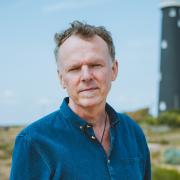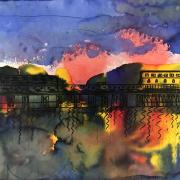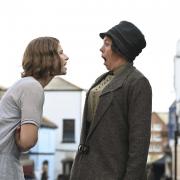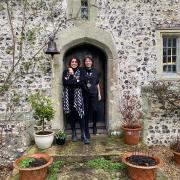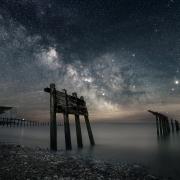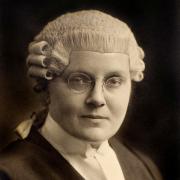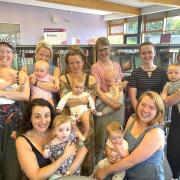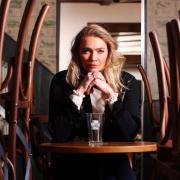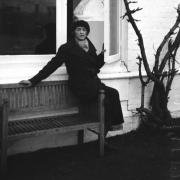For Brighton artist Steve Geliot, reduced light pollution during lockdown presented a once-in-a-lifetime opportunity to capture the beauty of the night sky | Words and Photos: Steve Geliot

I went on my first night walk when I was 15. It was during that horrible interval between sitting my O level exams and then getting the results many weeks later in the summer holidays.
Feeling I needed something to distract me during this anxiety-inducing wait, I went out one night at about 11pm, walking a couple of miles through the dark Kentish woods and on to the graveyard at the village church, before returning home beneath more open starry skies, framed on each side by the silhouettes of high hedges and fruit trees.
I found the experience exhilarating and inspiring. Now, many years later, noctambulism has become integral to my practice as an artist and sculptor. One of the reasons I settled in Brighton at the end of my degree is the easy access to the generous open curves of the South Downs.

A favourite location for my night walks is High and Over, looking down the River Cuckmere. Not only is this an excellent spot for filming the moonlit mist flowing down the valley, but it offers incredibly atmospheric soundscapes by day and especially at night.
I was thrilled to discover relatively recently that my grandparents had their honeymoon in Alfriston, and spent blissful days walking this landscape a couple of years before the war.
Mary was a painter and Frank was a stained glass artist, and also, a couple of years later, a fireman in the Blitz. They found this landscape very sustaining, Frank describing the Sussex air as “meaty”.

Shooting time-lapses of the moon rising over the river, or the Milky Way arching overhead, as the earth spins under your feet and the mists magically appear over the water, is always accompanied by echoing calls of tawny owls hunting about the valley, foxes, geese, skylarks and wigeon – all these sounds bouncing off the steep valley sides, interrupted occasionally by rude bellows from cattle down in the wet pastures.
The Cuckmere Valley is a fantastic part of the South Downs National Park’s Dark Skies Reserve. To my mind this is arguably more precious than any other dark sky reserve in the UK, as down here in Sussex we get fewer cloudy nights than places like Wales and Scotland, which all too often tend to be caught up in the Atlantic cloud systems blowing in from the west.
When you are filming at night, if you move quietly, often the wildlife simply doesn’t notice you.

Very recently, as I was walking back from filming near the Long Man of Wilmington, I heard the distinctive rummaging of some badgers emerging from their sett. I managed to set my camera up and got to within arm’s-length of one of them.
When he finally sensed my presence he suddenly froze, then, slowly turning his head, he saw me right next to him, jumped out of his skin, and shot off into the trees. It was a hilarious cartoon encounter that left me chuckling into my camera.
Back in March, when it became obvious that the lockdown was coming, I realised that without all the aircraft in the sky creating cloud trails, and with much less pollution from road traffic, the coming weeks were going to be a once-in-a-lifetime opportunity to photograph the night sky in all its natural clarity. Scientists have already dubbed the lockdown period the first “anthropause”.

What follows is an entry from my night-walking diary, from one of the most memorable nights of lockdown. It records, along with the photographs on these pages, a single example of what the glorious night could be like again should we finally get our act together on light pollution.
15-16 May 2020 - 12.19am
I drew into the car park at Birling Gap just before low tide, hoping to get some nice reflections of stars in the rock pools. I was wearing the smart new wellies my daughter had given me for my birthday, so I could slosh about in the shallows a bit.

Of course, when it came to the practice over the theory, in the dark, I completely misjudged how shallow these shallows actually are and my wellies got filled anyway. I began making photographs on the Seaford Head side, where the retreating tide reveals a large patch of reflective wet sand surrounded by pebbles, and then worked my way eastwards.
I took a few photos of the cliffs where there had been a recent fall, and the newly cleaved chalk gleamed with dentist whiteness in the starlight, as the galactic core of the Milky Way arched overhead.
As the tide receded to its farthest point, and the constant waves broke gently in the distance, I carefully picked my way out into the rock pools to try and get some of those stars reflected in them. As I moved the tripod to change a composition, its legs brushed through the water, which suddenly erupted with bright blue light. It was bioluminescent plankton.

This other-worldly glow has been such a feature of my reverie that I made a drawing of it last year from my imagination but now, as I stumbled about the rock pools, they began to light up each time I disturbed the water. This realisation of a lifelong dream was bright and vivid.
The light was an intense blue flash lasting no more than a second, creating little galaxies amongst the black seaweed. Sometimes it went to the edges of the pools, defining their shape with a very sharp and detailed map-line of light, like a blue version of the glowing ember you get on the edges of a burnt piece of tissue paper.
It was too fleeting a moment, and anyway I was far too excited, to work out how to photograph it. It was as if I was seeing thought processes flash across a brain-scan of the seashore.
How I do it
- I shoot with a Sony A7 III mirrorless DSLR, which is a low light specialist, and has amazing video apabilities. I have designed my own hybrid log gamma profile to give film the look I like
- In terms of glass I tend to prefer shooting with fast primes. Two favourite lenses are the Zeiss Batis 40mm F2 which is extremely sharp and has superb colour rendition. Then for wide shots I use a Sigma 20 mm F 1.4
- A tripod is essential, and sometimes for video I use a gimbal stabiliser to get nice smooth camera moves
- For sound I use a four-channel zoom mic and a stereo shotgun mic
- I always take a torch, a well-charged phone, and I put a note in my car windscreen with my phone number, which is especially important if you are taking photos at Beachy Head
- I always tell my family roughly where I am heading, and use the what3words app to give a precise location if needed. There is no signal beneath the cliffs, so great caution and good planning are vital. I sometimes have a fellow photographer buddy up with me
- For planning the shoots I look at multiple weather forecasts and satellite images, tide tables and an app called The Photographer’s Ephemeris to tell me where the moon and the stars will be at any given time
- Frequently things don’t work out as planned, but equally frequently something amazing is there. The important thing is to get out there and tread softly






